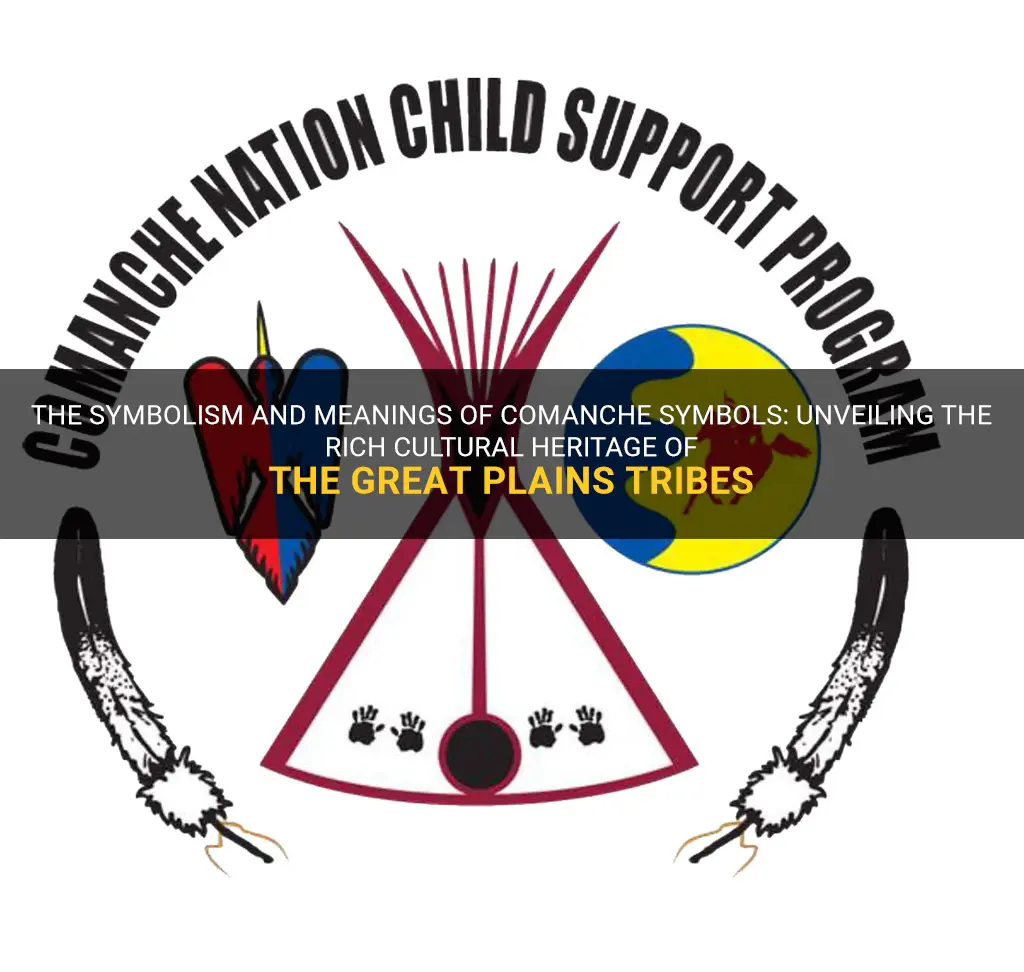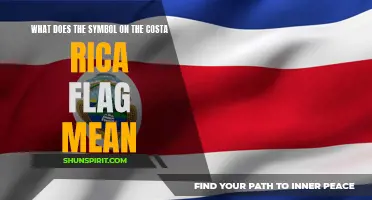
Comanche symbols and their meanings are deeply rooted in the rich cultural heritage of the Comanche people – one of the most famous warrior tribes of the American Great Plains. These symbols, which encompass everything from animal motifs to religious and spiritual symbols, were not only significant in battle or daily life but also played a pivotal role in preserving and passing down the tribe's traditions and beliefs from generation to generation. Each symbol carries a unique meaning, representing the profound connection the Comanche people have with their land, ancestors, and the natural world around them. Exploring the intricate world of Comanche symbols offers glimpses into their fascinating history, traditions, and way of life.
What You'll Learn
- What are some common symbols used by the Comanche Indians and what do they represent?
- How do the symbols and their meanings vary among different Comanche tribes or bands?
- Are there any modern uses of Comanche symbols in contemporary art or cultural expressions?
- How were Comanche symbols traditionally used in rituals and ceremonies?
- Are there any resources or experts available for further study of Comanche symbols and their meanings?

What are some common symbols used by the Comanche Indians and what do they represent?
The Comanche Indians have a rich cultural heritage and are known for their distinctive symbols and artwork. These symbols carry deep meanings and reflect the tribe's beliefs, traditions, and natural surroundings. Here are some common symbols used by the Comanche Indians and what they represent:
- The Buffalo: The buffalo holds great significance in Comanche culture. It represents strength, abundance, and prosperity. The Comanche people relied on the buffalo for survival, using its meat for food, its hide for clothing and shelter, and its bones for tools and weapons. The buffalo symbolizes the tribe's deep connection to the land and their ability to thrive in harmony with nature.
- The Eagle: The eagle is considered a sacred bird in Comanche culture and represents power, wisdom, and spiritual connection. It is believed that the eagle carries prayers to the heavens and brings blessings to the people. The eagle symbolizes the Comanche's strong spiritual beliefs and their reverence for the natural world.
- The Sun: The sun is a symbol of life, light, and warmth in Comanche culture. It represents vitality and the cycle of life. The sun is also associated with the creator and is seen as a powerful force that sustains all living beings. The Comanche people believe that the sun provides them with guidance and protection.
- The Horse: The horse holds great importance in Comanche culture as it was their primary mode of transportation and played a crucial role in their way of life. The horse symbolizes freedom, courage, and resilience. It is also seen as a spiritual guide that helps the Comanche people navigate through life's challenges.
- The Lightning Bolt: The lightning bolt is a symbol of power, energy, and strength in Comanche culture. It represents the powerful forces of nature and the ability to overcome obstacles. The lightning bolt is also associated with the Thunderbird, a mythical creature that brings rain and fertility to the land.
- The Arrow: The arrow is a symbol of protection and defense in Comanche culture. It represents the warrior spirit and the ability to overcome adversity. The Comanche people were known for their exceptional skills in hunting and warfare, and the arrow symbolizes their bravery and skill in battle.
These symbols are not just decorative elements; they hold deep cultural and spiritual significance for the Comanche people. They serve as reminders of their connection to the land, their ancestors, and their traditional way of life. Today, these symbols continue to be used in Comanche art, jewelry, and regalia, keeping the tribe's rich cultural heritage alive.
The Meaning Behind the RN Symbol and Its Importance in the Medical Field
You may want to see also

How do the symbols and their meanings vary among different Comanche tribes or bands?
The Comanche people are Native American tribes and bands that historically lived in the Southern Plains of North America. They are known for their rich culture, which includes a complex system of symbols that hold significant meanings within their communities. These symbols vary among different Comanche tribes or bands, reflecting their distinct histories, experiences, and influences.
One symbol that is commonly seen among various Comanche tribes is the buffalo. The buffalo holds great importance as a symbol of strength, abundance, and spiritual connection. It represents the Comanche people's deep relationship with the natural world and their dependence on the buffalo for their survival. However, the interpretation of the buffalo symbol may differ slightly among different Comanche tribes, with some emphasizing its importance as a source of food and resources, while others may focus more on its spiritual significance.
Another symbol that can vary among different Comanche tribes is the eagle. The eagle is a potent symbol of freedom, power, and spirituality in many Native American cultures. Among the Comanche, the eagle may represent a connection to the heavens and the spiritual realm. However, the specific meanings associated with the eagle symbol can differ among different Comanche tribes, reflecting variations in their tribal traditions, beliefs, and experiences.
Other symbols that may vary among Comanche tribes include the horse, the sun, and various geometric patterns. The horse is an essential symbol for many Native American tribes, including the Comanche, who were known for their horsemanship and reliance on horses for warfare and transportation. The sun is often associated with renewal, strength, and vitality, but its specific meanings and interpretations can vary among different Comanche tribes. Similarly, geometric patterns, such as circles, spirals, and diamonds, are prevalent in Comanche art and represent various concepts and meanings that may vary among different tribes.
The variations in symbol meanings among different Comanche tribes or bands can be attributed to several factors. These include geographical location, historical events, intertribal interactions, and individual interpretations. Each tribe or band may have unique stories, myths, and traditions that shape the meanings ascribed to specific symbols. Additionally, over time, the Comanche people have interacted with other tribes, such as the Kiowa and Apache, who have their own symbolic systems. These interactions have influenced and enriched the symbolism within the Comanche culture.
It is essential to appreciate the diverse interpretations and meanings associated with symbols among different Comanche tribes. This variety reflects the richness and complexity of their culture and highlights the importance of cultural diversity within the broader Native American community. Understanding these variations in symbol meaning can deepen our appreciation for the Comanche people's history, beliefs, and way of life.
The Meaning Behind the Moon Symbol on Instagram
You may want to see also

Are there any modern uses of Comanche symbols in contemporary art or cultural expressions?
The Comanche people are a Native American tribe that originated in the Great Plains region of North America. They have a rich cultural heritage that includes unique symbols and artwork. While many traditional Comanche symbols and designs have been passed down through generations, there has also been a resurgence of interest in these symbols in contemporary art and cultural expressions.
In recent years, there has been a growing movement to revive and celebrate indigenous cultures. This has led to a renewed interest in traditional Comanche symbols and their incorporation into modern art forms. Comanche artists and designers have been incorporating these symbols into various mediums, such as paintings, sculptures, jewelry, and clothing.
One common Comanche symbol that is often seen in contemporary art is the "sunrise" symbol. This symbol represents new beginnings and the start of a new day. It is often depicted as a circle with curved lines radiating outwards, representing the rising sun. Modern artists have used this symbol to convey themes of hope, rebirth, and cultural resilience.
Another popular Comanche symbol is the "thunderbird." In Comanche mythology, the thunderbird is a powerful and supernatural being associated with storms and rain. It is often depicted as a large bird with wings spread wide. This symbol has been used by contemporary artists to represent the strength and resilience of the Comanche people, as well as their connection to nature and the spiritual realm.
In addition to visual art, Comanche symbols have also found their way into other cultural expressions. For example, traditional Comanche designs are often incorporated into beadwork and embroidery, which are commonly used to decorate clothing and accessories. These intricate designs can be seen on items such as handbags, moccasins, and traditional dance regalia.
The use of Comanche symbols in contemporary art and cultural expressions is not limited to Comanche artists alone. Many non-indigenous artists and designers have also been inspired by these symbols and incorporate them into their work as a sign of respect and appreciation for indigenous cultures. This cultural exchange helps to bridge the gap between different communities and promotes a greater understanding and appreciation for Native American heritage.
In conclusion, there are indeed modern uses of Comanche symbols in contemporary art and cultural expressions. These symbols hold deep cultural significance for the Comanche people and are being celebrated and incorporated into various art forms. Whether it's in paintings, sculptures, jewelry, or clothing, Comanche symbols continue to inspire and enrich modern artistic expression.
Exploring the Powerful Meanings Behind Family Symbols
You may want to see also

How were Comanche symbols traditionally used in rituals and ceremonies?
Comanche symbols were an integral part of their culture and were traditionally used in rituals and ceremonies. These symbols had deep spiritual and cultural meanings and were used to communicate and express the Comanche people's beliefs, traditions, and histories.
One of the main ways Comanche symbols were used in rituals and ceremonies was through body painting. The warriors would paint intricate symbols on their bodies using natural pigments made from plants and minerals. Each symbol had a specific meaning and purpose, and the warriors would choose the symbols that best represented their intentions for the ritual or ceremony. The body painting was believed to enhance the spiritual connection between the individual and the universe, and it also served to intimidate enemies and showcase the warrior's bravery and power.
In addition to body painting, Comanche symbols were also incorporated into their regalia, such as headdresses, shields, and clothing. These symbols were often embroidered or painted onto the fabric using vibrant colors. The regalia served as a visual representation of the individual's identity and role within the community. It also helped to distinguish the different groups and clans within the Comanche society.
During rituals and ceremonies, symbols were also used to invoke the presence and guidance of the spirits and ancestors. The Comanche believed that these symbols had a sacred power that could help them connect with the spiritual realm and seek blessings and protection. Shamans and spiritual leaders would often use specific symbols during healing ceremonies, vision quests, and other spiritual practices to channel divine energy and gain insight into the spiritual world.
Furthermore, Comanche symbols were used to tell stories and preserve their history and heritage. The symbols were often depicted on buffalo hides, tipis, and other surfaces as a form of pictorial language. These pictographs were not only used to convey information but also served as a way to honor and remember important events, such as battles, migrations, and the heroic deeds of their leaders. The symbols were passed down from generation to generation, ensuring that the Comanche culture and traditions were preserved and celebrated.
In conclusion, Comanche symbols played a crucial role in their rituals and ceremonies. They were used to enhance spiritual connections, communicate beliefs, and express identity. Whether through body painting, regalia, or pictographs, these symbols embodied the rich cultural heritage of the Comanche people and helped to maintain their traditions and history.
The Symbolic Meanings Behind Vivienne Westwood's Iconic Designs
You may want to see also

Are there any resources or experts available for further study of Comanche symbols and their meanings?
The Comanche people have a rich cultural heritage, including a unique system of symbols that hold deep meaning within their society. These symbols often represent important concepts, stories, or spiritual beliefs. If you are interested in further studying Comanche symbols and their meanings, there are several resources and experts available to help you.
One helpful resource is the Native American Art and Culture website. This website offers a comprehensive overview of different Native American tribes, including the Comanche. They provide information on the symbolism used by the tribe, as well as explanations for many of the most common symbols. By exploring this resource, you can gain a better understanding of the meaning behind these symbols.
Another valuable resource is the book "The Power of the Seed: An Adult Coloring Book featuring Native American Symbols." This book features beautiful illustrations of Native American symbols, including those used by the Comanche. Each symbol is accompanied by a description of its meaning and significance within Comanche culture. This book is not only informative but also provides a creative way to engage with the symbols.
If you prefer a more interactive approach, there are experts who can guide you in your study of Comanche symbols. One such expert is Dr. Daniel P. Swan, a linguist and Native American language specialist. Dr. Swan has dedicated his career to studying and preserving Comanche language and culture. He has published several books on the subject and is available for lectures and workshops. By connecting with experts like Dr. Swan, you can learn directly from those who have devoted their lives to understanding and sharing Comanche traditions.
In addition to these resources, it can be valuable to engage with the Comanche community itself. Many Native American tribes have cultural centers or museums that offer educational opportunities and resources for those interested in learning more about their heritage. By visiting these centers, attending cultural events, or engaging with community members, you can gain a more nuanced understanding of Comanche symbols and their meanings.
Studying Comanche symbols and their meanings is a way to honor and respect the rich cultural heritage of the Comanche people. Whether you choose to utilize online resources, books, or connect with experts and the community, there are many opportunities available for those who are eager to learn. By immersing yourself in this knowledge, you can gain a deeper appreciation for the symbolism and significance that these symbols hold within Comanche culture.
The Hidden Meanings of Chinese Symbol Tattoos Behind the Ear
You may want to see also
Frequently asked questions
The Comanche symbol for a warrior represents bravery, strength, and honor. It is a proud symbol that signifies the warrior's dedication to protecting their people and their land.
The Comanche symbol for a buffalo represents abundance, sustenance, and the importance of the buffalo as a sacred animal. It is a symbol of gratitude and reverence for the buffalo's role in providing food, clothing, and shelter for the Comanche people.
The Comanche symbol for a tepee symbolizes the importance of the home and family within Comanche culture. It represents the central place where the Comanche people gather and live, and it is a symbol of community, warmth, and protection.
The Comanche symbol for a horse represents freedom, power, and the importance of horses in Comanche life. Horses were essential to the Comanche people for transportation, hunting, and warfare, and they are highly valued and respected.
The Comanche symbol for a sun represents light, warmth, and life. It symbolizes the power and energy of the sun, which is essential for the growth of crops, the sustenance of animals, and the overall well-being of the Comanche people. The sun symbol is also associated with spirituality and the connection to the higher forces of the universe.







